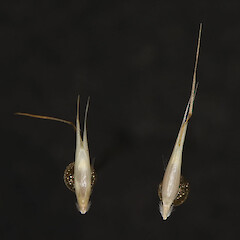Rytidosperma merum
Synonyms
Austrodanthonia mera (Connor et Edgar) H.P.Linder
Family
Poaceae
Flora category
Vascular – Native
Endemic taxon
Yes
Endemic genus
No
Endemic family
No
Structural class
Grasses
NVS code
The National Vegetation Survey (NVS) Databank is a physical archive and electronic databank containing records of over 94,000 vegetation survey plots - including data from over 19,000 permanent plots. NVS maintains a standard set of species code abbreviations that correspond to standard scientific plant names from the Ngä Tipu o Aotearoa - New Zealand Plants database.
RYTMER
Current conservation status
The conservation status of all known New Zealand vascular plant taxa at the rank of species and below were reassessed in 2017 using the New Zealand Threat Classification System (NZTCS) – more information about this can be found on the NZTCS website. This report includes a statistical summary and brief notes on changes since 2012 and replaces all previous NZTCS lists for vascular plants.
Please note, threat classifications are often suggested by authors when publications fall between NZTCS assessment periods – an interim threat classification status has not been assessed by the NZTCS panel.
- Conservation status of New Zealand indigenous vascular plants, 2017 . 2018. Peter J. de Lange, Jeremy R. Rolfe, John W. Barkla, Shannel P. Courtney, Paul D. Champion, Leon R. Perrie, Sarah M. Beadel, Kerry A. Ford, Ilse Breitwieser, Ines Schönberger, Rowan Hindmarsh-Walls, Peter B. Heenan and Kate Ladley. Department of Conservation. Source: NZTCS and licensed by DOC for reuse under the Creative Commons Attribution 4.0 International licence.
2017 | At Risk – Declining | Qualifiers: DP, Sp
Previous conservation statuses
2012 | Threatened – Nationally Vulnerable | Qualifiers: DP, Sp
2009 | Data Deficient | Qualifiers: DP
2004 | Sparse
Distribution
Endemic. New Zealand: North Island (Kaingaroa Plains and Kaimanawa Mountains, eastern Wairarapa and Aorangi Range), South Island (Marlborough, Canterbury, Otago—near Alexandra and Sutton Salt Lakes, Middlemarch).
Habitat
Lowland to montane (100–800 m a.s.l.) in dry sites, usually in open short-tussock grassland but also on rock outcrops.
Detailed description
Rather fine-leaved, densely tufted, light green, shortly rhizomatous grass. Older growth distinctly straw-coloured, with long, drooping or trailing culms; leaves very much less than culms; branching extra or intervaginal. Leaf-sheath pale stramineous, glabrous with a sparse apical tuft of hairs up to 1.5 mm long. Ligule 0.1–0.2 mm. Leaf-blade 250–400 mm, more or less flat, glabrous, occasionally with a few sparse, scattered hairs, margins scabird. Culm very slender, tawny with smooth internodes otherwise minutely scabrid belwo inflorescence, elongating to 0.14 m (or more) at maturity. Inflorescence a raceme or racemose panicle with 1–2 short branches at base, slender to 80 mm, comprising few narrow, sessile to subsessile spikelets; rachise and pedicels finely scabrid with longer fine hairs on margins especially below spikelets. Spikelets 4–6-flowered, awns exserted from glumes. Glumes light green, occasionally purplish, lanceolate, subobtuse 7–15 mm, more or less equal, 5–7-nerved. Lemma 2.5–4 mm, 7–9-nerved, upper row of hairs in small marginal tufts only, about equal to lemma or occasionally with upper tufts absent, lower row in small marginal tufts only, or a few small tufts or single hairs on margin; lobes 3–8.5 mm, soon tapering to a fine awn; central awn 6.5–14 mm, column 2.5–3.5 mm. Palea 2.5–5 mm, > upper lemma hairs, interkeel and margins glabrous. Callus 0.6–1 mm, marginal hair tufts rarely reaching base of lower lateral tufts. Rachilla 0.5–0.6 mm. Anthers 0.3–1.5 mm. Seed 1.7–2.5 × 0.9–1.2 mm.
Manaaki Whenua Online Interactive Key
Similar taxa
One of the more distinctive species in Rytidosperma. Most frequently confused with the naturalised R. racemosum (R.Br.) Connor et Edgar from which it differs by the much shorter leaves than culms, finer leaves, long, drooping and trailing culms, and by the lemma hairs in two pairs of marginal tufts, rarely with a few single hairs in a lower row, and by the short, stout, callus up to 1 mm long. In R. racemosum the lemma hairs form a continuous lower row, and an interrupted, tufted, upper row, and the callus is long (up to 1.5 mm) and distinctly narrower than in R. merum.
Flowering
October–December
Fruiting
November–April
Propagation technique
Easily grown from fresh seed and rooted pieces. Dislikes humidity.
Threats
Not known to be threatened but apparently very uncommon throughout its range. Can be very common at the few sites it is known from.
Etymology
rytidosperma: Wrinkled seed
Where To Buy
Not commercially available
Attribution
Description modified from Edgar and Connor (2000).
References and further reading
Edgar E, Connor HE. 2000. Flora of New Zealand. Vol. V. Grasses. Manaaki Whenua Press, Christchurch, NZ. 650 p.






